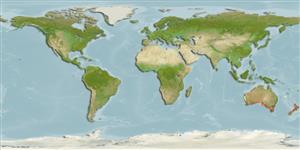>
Mugiliformes (Mullets) >
Mugilidae (Mullets)
Etymology: forsteri: Named for F.C. Aldrich, former Chief Inspector of Fisheries and Game, Western Australia and J.R. Forster, naturalist on Cook's second voyage to New Zealand (Ref. 9003).
More on author: Valenciennes.
Environment: milieu / climate zone / depth range / distribution range
Οικολογία
Θαλασσινό(ά); Γλυκού νερού; Υφάλμυρο βενθικό(ς); κατάδρομος (Ref. 46888); εύρος βάθους 0 - 50 m (Ref. 9003), usually 0 - 10 m (Ref. 9812). Temperate; ? - 28°C (Ref. 28706); 25°S - 47°S, 112°E - 173°W
Southwest Pacific: throughout New Zealand and the Chatham Islands; also from eastern, western Australia, southern Australia and Tasmania.
Μέγεθος / Βάρος / Age
Maturity: Lm ? range ? - ? cm
Max length : 50.0 cm SL αρσενικό/απροσδιόριστο; (Ref. 44894); common length : 25.0 cm TL αρσενικό/απροσδιόριστο; (Ref. 9258); μεγ. δημοσιευμένο βάρος: 950.00 g (Ref. 26498); μεγ. αναφερόμενη ηλικία: 7 έτη (Ref. 9003)
Ραχιαίες άκανθες (συνολικά): 5; Μαλακές ραχιαίες ακτίνες (συνολικά): 9; Εδρικές άκανθες 3; Μαλακές εδρικές ακτίνες: 12. More pointed head and mouth than Mugil cephalus, and their eyes lack adipose (fatty) eyelids. Body scales are small (54-64 between gill opening and tail base) and thin, and are easily dislodged. 2 widely separated dorsal fins, the first with 4 spines and the second with 1 spine and 9 rays. These fish are olive or bluish brown above and silvery on the sides, and their eyes are bright yellow or golden. The fins have brown margins.
Found over sandy and muddy bottoms of coastal waters, bays, estuaries, and may ascend rivers into freshwaters (Ref. 9812, 44894). Adults inhabit brackish coastal lakes (Ref. 44894). Found in schools (Ref. 9812). Shoal-forming (Ref. 44894). They are omnivores, feeding mostly on benthic detritus, algae and small invertebrates. Oviparous, eggs are pelagic and non-adhesive (Ref. 205). Spawn in coastal waters in summer and autumn, probably in estuaries (Ref. 9812, 27012, 28470, 28707, 28708). Marketed fresh (whole gutted or fillets), smoked, salted or as roe (Ref. 3383).
Yellow eye mullet form large aggregations prior to spawning (Ref. 6390).
Kailola, P.J., M.J. Williams, P.C. Stewart, R.E. Reichelt, A. McNee and C. Grieve, 1993. Australian fisheries resources. Bureau of Resource Sciences, Canberra, Australia. 422 p. (Ref. 6390)
IUCN Red List Status (Ref. 130435)
Human uses
αλιεία: Εμπορικό(ά); αλιεία αναψυχής: ναί
Περισσότερες πληροφορίες
ΣυνεργάτεςΦωτογραφίεςStamps, Coins Misc.ΉχοιΣιγκουατέραΤαχύτηταΚολυμβητικός ΤύποςΕπιφάνεια βραγχίωνOtolithsΕγκέφαλοιΌραση
Εργαλεία
Special reports
Download XML
Διαδικτυακές πηγές
Estimates based on models
Preferred temperature (Ref.
123201): 13.5 - 20.2, mean 17.1 °C (based on 354 cells).
Phylogenetic diversity index (Ref.
82804): PD
50 = 1.0000 [Uniqueness, from 0.5 = low to 2.0 = high].
Bayesian length-weight: a=0.01175 (0.00558 - 0.02474), b=2.96 (2.79 - 3.13), in cm total length, based on LWR estimates for this (Sub)family-body shape (Ref.
93245).
Τροφικό Επίπεδο (Ref.
69278): 2.5 ±0.26 se; based on food items.
Generation time: 2.2 ( na - na) years. Estimated as median ln(3)/K based on 1
growth studies.
Ελαστικότητα (Ref.
120179): Μεσαίο(α), ελάχιστος χρόνος για διπλασιασμό πληθυσμού 1,4 - 4,4 έτη (tm=2-3; tmax=7; Fec=125,000).
Fishing Vulnerability (Ref.
59153): Low to moderate vulnerability (29 of 100).
Nutrients (Ref.
124155): Calcium = 45.6 [15.7, 139.4] mg/100g; Iron = 0.36 [0.14, 1.08] mg/100g; Protein = 18.4 [16.4, 20.5] %; Omega3 = 0.804 [0.340, 1.805] g/100g; Selenium = 34.3 [12.1, 99.0] μg/100g; VitaminA = 8.44 [1.77, 41.50] μg/100g; Zinc = 0.918 [0.449, 1.692] mg/100g (wet weight); based on
nutrient studies.
